
Spinifex longifolius, commonly known as beach spinifex, is a perennial grass that grows in sandy regions along the seacoast. It also lives in most deserts around Australia.
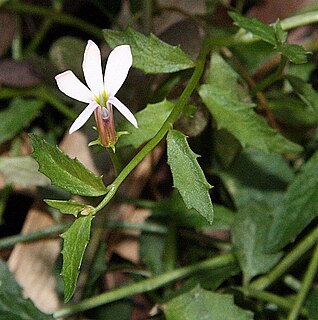
Lobelia purpurascens, commonly known as white root or purplish pratia, is a flowering plant in the family Campanulaceae of eastern Australia. It is a small herbaceous, scrambling plant with white to pale pink flowers.
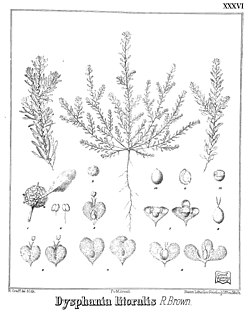
Dysphania littoralis, the red crumbweed, is a small, prostrate annual plant flowering year round.
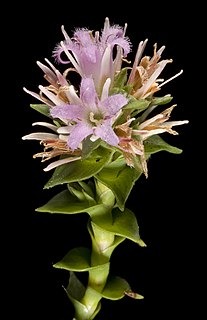
Andersonia sprengelioides is a species of shrub that grows in the south west corner of Western Australia. It was originally described by the botanist Robert Brown in 1810 and retains its original name. The genus Andersonia is classified in the Ericaceae, or in the family Epacridaceae.
Hypolaena fastigiata, commonly known as tassel rope-rush, is a plant species in the family Restionaceae. It is endemic to Australia.

Leptocarpus is a genus of dioeceous rush-like perennial plants described as a genus in 1810.

Nymphoides geminata, commonly known as entire marshwort, is an aquatic plant of the family Menyanthaceae native to eastern Australia.

Desmocladus flexuosus is a rhizatomous, sedge-like herb in the Restionaceae family, endemic to south-west Western Australia.
Oreobolus is a genus of flowering plants in the family Cyperaceae. The genus has a circumpacific distribution.

Ptilothrix deusta is a sedge in the family Cyperaceae found in south eastern Australia. It is commonly seen in wet sandy soils in heathland, growing from 30 to 60 cm tall. This is one of the many plants first published by Robert Brown with the type known as "(J.) v.v." appearing in his Prodromus Florae Novae Hollandiae et Insulae Van Diemen in 1810 as Carpha deusta. It was transferred to the genus, Ptilothrix, in 1994 by Karen Wilson. The genus name is derived from ancient Greek, meaning feather hair. The specific epithet deusta is derived from the Latin with a meaning of burnt.

Epacris sparsa, is a small upright shrub with creamy-white flowers, elliptic to egg-shaped leaves and reddish new growth. It is endemic to New South Wales with a restricted distribution.

Pimelea angustifolia, commonly known as narrow-leaved pimelea, is a small upright, slender or open shrub with whitish, cream, yellow or pink flowers. It is endemic to Western Australia.

Chaetanthus aristatus is a species of rush. It is found in Western Australia.
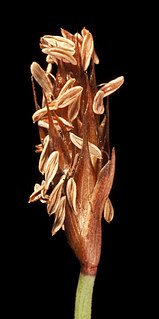
Chordifex laxus is a rush species of the genus Chordifex in the family Restionaceae. It is endemic to the south-west of Western Australia.
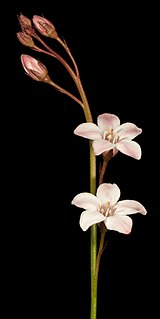
Samolus junceus in the family Primulaceae is a species of water pimpernel native to Western Australia.

Scaevola striata, commonly known as royal robe, is a species of flowering plant in the family Goodeniaceae. It has blue fan-shaped flowers, and is endemic to Western Australia.
Chloanthes glandulosa is a species of flowering plant in the family Lamiaceae. It is a small shrub with wrinkled leaves and greenish-yellow tubular flowers. It is endemic to New South Wales.

Tremulina tremula is a plant in the Restionaceae family, found in the south-west of Western Australia.
Cyperus enervis is a species of sedge that is endemic to eastern Australia.

Microcorys barbata is a plant in the Lamiaceae family, native to Western Australia. It was first described by Robert Brown in 1810.















